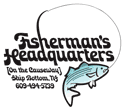You remember the other day when I was wondering out loud where the hell do all those commercially caught striped bass end up since I never seen it on any restaurant I frequent? You are going to get a kick out of this news story posted on Yahoo Health yesterday about fish sold in NY.
Fish sold in New York is routinely mislabeled: study
By Peter Rudegeair, Reuters
Dec. 11, 2012 8:25AM PSTDec. 11, 2012 8:25AM PST
NEW YORK (Reuters) – Nearly three in five New York City grocery stores and restaurants that sell seafood have mislabeled part of their stock, substituting varieties that could cause health problems, according to a new study.
Some 39 percent of the fish obtained for the study by the ocean conservation group Oceana was inaccurately identified, Oceana said. Sometimes cheap fish is substituted for more expensive varieties or plentiful species for scarce ones.
Forensic DNA analysis revealed 58 percent of 81 New York retailers and eateries sampled incorrectly labeled the seafood they sold, according to the study released Tuesday.
“It’s unacceptable that New York seafood lovers are being duped more than one-third of the time when purchasing certain types of fish,” Kimberly Warner, a senior scientist at Oceana and an author of the study, said in a news release.
In some instances, consumers unknowingly purchased fish that could pose health risks.
Blueline tilefish masqueraded as halibut and red snapper. The FDA urges pregnant women, nursing mothers and small children to avoid tilefish given its high mercury content.
All but one of the 17 white tuna samples obtained from sushi restaurants turned out to be escolar, a fish whose diarrhea-inducing properties earned it the nickname the “ex-lax fish.”
Mislabeled seafood can present a public health concern because many hazards are species specific, a U.S. Food and Drug Administration (FDA) spokeswoman said in an email. Allergic reactions and food-borne illnesses are some of the possible health hazards, the spokeswoman said.
New York’s rate of seafood mislabeling was higher than Miami’s (31 percent) but lower than that of Boston (48 percent) and Los Angeles (55 percent), according to recent Oceana investigations.
What distinguishes New York’s seafood marketplace from those of the other American cities Oceana tested is the presence of smaller, independent food stores, 40 percent of which sold mislabeled fish, Warner said in an interview. In contrast, only 12 percent of seafood bought at national chain grocery stores in New York were labeled incorrectly.
The problem is not new. A study appearing in a 1992 issue of Consumer Reports found about a third of the seafood sampled in New York, Chicago, and San Jose was incorrectly labeled.
Nor is seafood mislabeling an issue that has gone unreported. The discovery in August 2011 that Zabar’s, a gourmet food store on Manhattan, had been passing off crawfish as lobster in its lobster salad for at least 15 years was the subject of multiple, high-profile media stories.
(Additional reporting by Sharon Begley; Editing by Cynthia Osterman












I thought of your question when I saw this story yesterday. Oceana does a lot of work on exposing seafood mislabeling, check it out:
oceana.org/fraud
↓I was a comercial fisherman for a long time. My wife worked in the offices of fish plants for a long time, thats how we met. For years we have gotten a kick out of the seafood counter.
↓What I wrote a little over a year ago in response to the similar Boston Globe article:
_______________________________________________________________
Boston Globe article (10/23/11) about “misrepresentation”
——————————————————————————–
I have always said it and I even wrote about it here in “Ask Frank”. Exactly what this article is addressing: The Mis-representation of Seafood Products and the rampant fraud that goes along with it. What they don’t mention here is the issue that concerns me most and that is because they were testing here in Massachusetts. Striped Bass are being sold from Florida to California as “grouper”, “red snapper”, “sea bass” or whatever is popular (and expensive) in that geographic area at that time. The key is this is being done when bass are “cheap”. At this time of year when the legal harvest from the northern states (Ma., RI, NY) is in full swing (May-November) the prices remain high as the supply is readily handled by the demand. Even the poaching, which I am sure more than doubles the tonnage put into the supply chain can’t hurt the price to a significant degree.
↓However, in the winter months, when the netters are in full gear and their poaching takes it’s toll, that is a different story! Bass go from “northern prices” of $2.50-$4.50 to the boats to “southern prices”: down to $1.00-$2.00 to the boats. This is because the southern producer states (Md., De., Va., NC) catch far more bass in a shorter period of time. The wholesalers take advantage of these lower prices to maximize prices by shipping these less expensive fish to areas of the country that are willing to pay a higher margin to them. This is mostly done with fully known fraud. The restaurants and hotels in Las Vegas, Pheonix, Miami and L.A. all know they are not getting grouper but the supplier tells them it is a great, fresh and cheaper substitute……….JC
__________________________________________________ ______________________
Captain Jason Colby
Little Sister Charters
been going on forever, nothing at all new, and totally criminal.
↓Grouper bait & switch is an old trick in the business. Many times the “grouper” is bass sold with the skin side peeled and facing up instead of the fillet side up…the list goes on & on.
↓Mislabeling, while chronic at best with no obvious retribution to be had by retailers, is seemingly light fare to FDA inspectors and nothing more than a cruel joke to unwitting consumers. While interesting in its own right, it still does not begin to explain where the Striped Bass harvested tonnage goes. It seems with quotas set by individual states, those same entities would have a vested interest on what demand drives those needed quotas and where the end user lies in the equation….still no obvious published public record exists…probably should be something that should be done to justify the quotas set by state and federal fisheries management groups…oh yeah, they’re short staffed underpaid government employees….we shouldn’t dare ask…
↓Was upstate in Troy, NY (ugh) for Thanksgiving and went to a farmers market while in town. Striped Bass was being sold for $22.00/lb.
↓If I don’t catch it,and clean it,I just don’t eat it,and you should do the same!
↓The commercial seafood industry is a joke!
↓Enforcement is the real joke. Why bother to advocate game fish status, CnR only, minimum size or maximum limit if those who disregard current regulations never expect to face any consequences? Clearly the vast majority of us here really care and most of us rarely keep more than a few fish per year for the table but without any teeth, any attempt to regulate our way to a healthy bass stock is a waste of time. Change the speed limit on the LIE to 50 then take away all the cops. Watch the lone dude in the HOV lane slow down. Fat chance. And to have ten different states with ten different sets of regulations for a fish that migrates up and down the eastern seaboard twice over an eight month period? That could be the first funny SNL skit since Eddie Murphy. On a happy note, i’m glad to hear SS will start to use VMC as their standard hook. Find the problem then fix it, funny how that works.
↓This is old news Zeno:
http://www.nytimes.com/2008/08/22/science/22fish.html?_r=0
↓The “mislabeling” of fish is about as old as the fishmonger himself. As others have said the market dictates what happens. It is so common in VA that the netters will drag at night and drop at the dock at night knowing the VA fish and game work a daylight schedule on the eastern shore. By the time the officers are coming to work the fish are allready headed up 13 thru MD to NJ/NY where they are processed and sold off for a tidy profit.
↓Brings back memories of being a bachelor in Long Beach back in the early ’90s, where one of the bars had a weekly special called “seafood remundo”. For $20 bucks it was a table of everything the cook had left in the fridge, various slabs of fish, shellfish, lobstah, etc. The usual suspects were a couple of young surf googs (ahem) and some older pinhookers which may or may not have provided some of the fare. Normally, any other night we would be trying to impress the opposite gender, but this night we didn’t care and they would watch by the bar somewhat appalled at the scene, straight out of Henry VIII or the Dark Crystal’s dinner scenes, as we filled some garbage cans with the carnage, shells, bones, etc.
We would try to guess what the catch was, and in sometimes a heated moment, compare notes with the cook. Usual misrepresentation was substituting Conch for scallops, but every now and then skate would be detected, usually also for scallops. It was interesting on how sometimes what was considered a “garbage fish” was snuck in, and how good it would taste. It was an education for all involved, too.
↓Good write JimM.
↓The skate as a scallop is pretty common in kitchens. The usual tell tale was the 1-1.5″ diamater sharpened pipe on the cook counter. A skate wing would get popped with the pipe cutting the scallops and in the saute’ pan they go…..
In all honesty if you cook them right you won’t tell the diffrence.
The gent who used to cook for that place had a couple of cookie cutters he’d use, and if he got the skate fresh, I’d never know, except maybe by texture. The tip-off of with skate-type fish was age (time of catch to table), where the ammonia taste had time to brew. He had some great recipes that complemented skate, wish I knew where he went too. Always wanted to try some of the recipes I’ve seen the in past SJ issues, one of these days… Good times, and we ate like kings.
↓